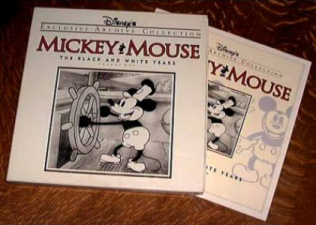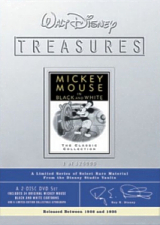Walt Disney Home Video (1928–1935), CAV, 5 discs/10 sides, 244 mins, 1.17:1–1.33:1 original full frame ratios, Digital Mono, Not Rated/Rated G
 Comparisons are almost always a matter of personal opinion. I remember when I reviewed the Walt Disney Treasures tin set Behind The Scenes At The Walt Disney Studio, I was struck by some of the images from Fantasia as seen on those originally broadcast films. Although the picture suffered from the odd scratch and pop, what did strike me was the quality of the color, and the depth of the image. Checking back against my Fantasia Legacy box set, the first thing that hits you is obviously the clarity of the digitally cleaned-up images. But does digital restoration also take out some of the “life” from the original film?
Comparisons are almost always a matter of personal opinion. I remember when I reviewed the Walt Disney Treasures tin set Behind The Scenes At The Walt Disney Studio, I was struck by some of the images from Fantasia as seen on those originally broadcast films. Although the picture suffered from the odd scratch and pop, what did strike me was the quality of the color, and the depth of the image. Checking back against my Fantasia Legacy box set, the first thing that hits you is obviously the clarity of the digitally cleaned-up images. But does digital restoration also take out some of the “life” from the original film?
The picture on the Fantasia 60th Anniversary edition is remarkable, although it is possible too clean. The colors, which we are told have been recreated as was originally intended, are strong and bold, but for me have lost a little of their vibrancy. Of course it’s back down to personal opinion, and there are those that would most certainly argue against my point, but this was just something I noticed as a matter of course in watching the old clips again.
And speaking of Walt Disney Treasures DVD comparisons, let’s swing the clock back and glance an eye over the Mickey Mouse In Black And White set’s LaserDisc counterpart in its original incarnation as Mickey Mouse: The Black And White Years. Subtitled “volume one”, the LD features pretty much the same amount and selection of classic, un-touched (by the colorization boys anyway) Mickey shorts. Packaging wise, both sets come as tip-top in design as each format will allow. I’ll assume you all know that the Mickey DVD has the outer embossed tin, with a standard double-disc keep-case tucked away inside. Within that is a nice eight-page booklet covering the contents and a reproduction lithograph featuring one of the Mouse’s famous poses. In the LD set, which comes housed in a massive 12-inch “slip case”-type box, the inner pullout tray holds five laserdiscs, as well as a wonderful eight-page booklet that measures the same dimensions.
The first real difference between the releases that delighted fans was the inclusion in the DVD of the extra cartoon The Karnival Kid, which did not appear on the LD version. Other than that, things are pretty similar content-wise, although the color Mickey footage from the LD box (the Parade Of The Nominees special animation segment) was included instead in the Mickey Mouse In Living Color tin, for obvious reasons. The quality of the cartoons on the LaserDisc set were in the best condition I had seen them up until that time. In the 90s, Disney embarked on a restoration effort that preserved much of its animated short output. Part of the reason for “rescuing” the early Mickey shorts was for the fact that they could be colorized and aired as “new” cartoons on the Disney Channel. Thankfully for LD and DVD collectors, these prints have been left in their original black and white state.
 There was a little irritation when the LD edition was issued, as the main title cards had supposedly been “lost” (due to excessive trimming for airing in The Mickey Mouse Club in the 1950s). The video engineers at Disney Home Video were able to mock up the look of the original 1930s titles and presented the cartoons as close as possible to their full condition. The quality for cartoons from this time is to be expected – prints have been duped, cut, re-cut, spliced back together again, and stored in not too great conditions. The LaserDisc shows off every minor imperfection, but this is all part of the charm in watching a collection of this type. Mickey has an affable, but very mischievous nature in these earlier toons, but over the years he and Minnie became an item, and hearing Walt perform Mickey’s voice (as well as Minnie’s occasionally!) is a delight, as there seems to be a real relationship going on here.
There was a little irritation when the LD edition was issued, as the main title cards had supposedly been “lost” (due to excessive trimming for airing in The Mickey Mouse Club in the 1950s). The video engineers at Disney Home Video were able to mock up the look of the original 1930s titles and presented the cartoons as close as possible to their full condition. The quality for cartoons from this time is to be expected – prints have been duped, cut, re-cut, spliced back together again, and stored in not too great conditions. The LaserDisc shows off every minor imperfection, but this is all part of the charm in watching a collection of this type. Mickey has an affable, but very mischievous nature in these earlier toons, but over the years he and Minnie became an item, and hearing Walt perform Mickey’s voice (as well as Minnie’s occasionally!) is a delight, as there seems to be a real relationship going on here.
The sound on these earlier cartoons is also as you might expect. Back then it was amazing just to have sound recorded onto the film, not least synchronized to the picture! Steamboat Willie, as I’m sure you all know, was the first Disney cartoon to feature sound, and was a cinematic breakthrough. That cartoon was included in the LD collection, but is presented on the Treasures DVD tin in a newly restored un-cut edition, which does not omit the rather more suspect ways that Mr Mouse plays the score from the film using the animals in the keep of his ship! When Steamboat Willie became a bona fide phenomenon, the two previous Mickey cartoons, Plane Crazy and The Gallopin’ Gaucho, were rushed into theaters with newly recorded soundtracks – Mickey was a star! The sets both present these first cartoons in their slightly windowboxed ratios of 1.17:1 (to accommodate the earlier, narrower screen size), but the quality in audio and video between the two editions of these black and white Mickey Mouse is more a case of flipping a coin to decide which is the better.
I actually found the video on the DVD to be sharper than the LD issue, although the audio on the LaserDisc felt “more direct” in that sound was fuller and a distinct “stereo” effect could definitely be witnessed. The DVD sounds more monaural, with ever so slightly less clarity, but then again it does have the sharper picture (due in part to the compression techniques filtering away some of the extra print activity). Between the two, there are very minor differences overall, and although I’ve seen a number of the LD sets going on eBay, the DVD actually replicates the experience quite well. Apart from the booklet found in the LD, the Treasures tin also contains one very important extra: Leonard Maltin.
 In keeping with the other titles in the Walt Disney Treasures line, film critic and Disney historian Maltin guides us through the collection. His great enthusiasm and obvious knowledge for his subject always shines through, and he sets up the films extremely nicely. There are several extra video clips on offer in the DVD set that the LD simply didn’t have room for (including a wonderful 18-minute interview with legendary animator Frank Thomas and Ollie Johnson). There’s much more, and even the story sketches and pencil test (for The Mail Pilot) from the LaserDisc set have been ported over. All in all, a must for Mickey fans, and I’d have to agree that owners of the LD box set just might want to check out the DVD edition before it totally disappears! Highly recommended!
In keeping with the other titles in the Walt Disney Treasures line, film critic and Disney historian Maltin guides us through the collection. His great enthusiasm and obvious knowledge for his subject always shines through, and he sets up the films extremely nicely. There are several extra video clips on offer in the DVD set that the LD simply didn’t have room for (including a wonderful 18-minute interview with legendary animator Frank Thomas and Ollie Johnson). There’s much more, and even the story sketches and pencil test (for The Mail Pilot) from the LaserDisc set have been ported over. All in all, a must for Mickey fans, and I’d have to agree that owners of the LD box set just might want to check out the DVD edition before it totally disappears! Highly recommended!

